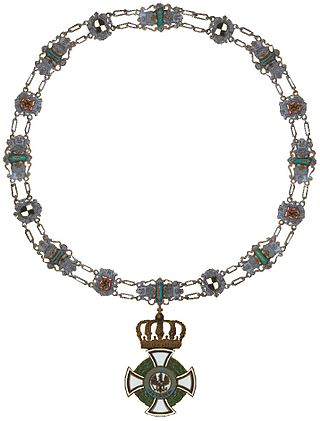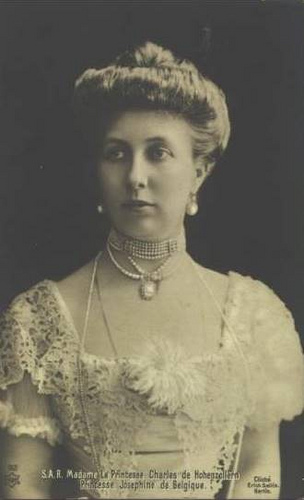Related Research Articles

The House of Hohenzollern is a formerly royal German dynasty whose members were variously princes, electors, kings and emperors of Hohenzollern, Brandenburg, Prussia, the German Empire, and Romania. The family came from the area around the town of Hechingen in Swabia during the late 11th century and took their name from Hohenzollern Castle. The first ancestors of the Hohenzollerns were mentioned in 1061.

Hohenzollern-Sigmaringen was a principality in southwestern Germany. Its rulers belonged to the senior Swabian branch of the House of Hohenzollern. The Swabian Hohenzollerns were elevated to princes in 1623. The small sovereign state with the capital city of Sigmaringen was annexed to the Kingdom of Prussia in 1850 following the abdication of its sovereign in the wake of the revolutions of 1848, then became part of the newly created Province of Hohenzollern.

Ferdinand I, nicknamed Întregitorul, was King of Romania from 10 October 1914 until his death in 1927. Ferdinand was the second son of Leopold, Prince of Hohenzollern, and Infanta Antónia of Portugal,. His family was part of the Catholic branch of the Prussian royal family Hohenzollern.

Carol I or Charles I of Romania, was the monarch of Romania from 1866 to his death in 1914, ruling as Prince (Domnitor) from 1866 to 1881, and as King from 1881 to 1914. He was elected Prince of the Romanian United Principalities on 20 April 1866 after the overthrow of Alexandru Ioan Cuza by a palace coup d'état. In May 1877, Romania was proclaimed an independent and sovereign nation. The defeat of the Ottoman Empire (1878) in the Russo-Turkish War secured Romanian independence, and he was proclaimed King on 26 March [O.S. 14 March] 1881. He was the first ruler of the Hohenzollern-Sigmaringen dynasty, which ruled the country until the proclamation of a socialist republic in 1947.

Sigmaringen is a town in southern Germany, in the state of Baden-Württemberg. Situated on the upper Danube, it is the capital of the Sigmaringen district.

Hohenzollern-Hechingen was a small principality in southwestern Germany. Its rulers belonged to the Swabian branch of the Hohenzollern dynasty.

Leopold, Prince of Hohenzollern was the head of the Swabian branch of the House of Hohenzollern, and played a fleeting role in European power politics in connection with the Franco-Prussian War.

Karl Anton, Prince of Hohenzollern-Sigmaringen was the last prince of Hohenzollern-Sigmaringen before the territory was annexed by the Kingdom of Prussia in 1849. Afterwards he continued to be titular prince of his house and, with the death of the last prince of Hohenzollern-Hechingen in 1869, of the entire House of Hohenzollern. He served as Minister President of Prussia from 1858 to 1862, the only Hohenzollern prince to hold the post. His second son, Karl, became king of Romania. The offer of the throne of Spain to his eldest son, Leopold, was one of the causes of the Franco-Prussian War, which led to the unification of Germany and the creation of the German Empire.

The House Order of Hohenzollern was a dynastic order of knighthood of the House of Hohenzollern awarded to military commissioned officers and civilians of comparable status. Associated with the various versions of the order were crosses and medals which could be awarded to lower-ranking soldiers and civilians.

Karl Friedrich Emich Meinrad Benedikt Fidelis Maria Michael Gerold Prinz von Hohenzollern is the eldest son of the late Friedrich Wilhelm, Prince of Hohenzollern and Princess Margarita of Leiningen. He became head of the Catholic Swabian branch of the House of Hohenzollern upon his father's death on 16 September 2010.

Stephanie Josepha Friederike Wilhelmine Antonia of Hohenzollern-Sigmaringen was Queen of Portugal from her marriage to King Peter V on 18 May 1858 until her death the following year.

William, Prince of Hohenzollern was the eldest son of Leopold, Prince of Hohenzollern and Infanta Antónia of Portugal.

Sigmaringen Castle was the princely castle and seat of government for the Princes of Hohenzollern-Sigmaringen. Situated in the Swabian Alb region of Baden-Württemberg, Germany, this castle dominates the skyline of the town of Sigmaringen. The castle was rebuilt following a fire in 1893, and only the towers of the earlier medieval fortress remain. Schloss Sigmaringen was a family estate of the Swabian Hohenzollern family, a cadet branch of the Hohenzollern family, from which the German Emperors and kings of Prussia came. During the closing months of World War II, Schloss Sigmaringen was briefly the seat of the Vichy French Government after France was liberated by the Allies. The castle and museums may be visited throughout the year, but only on guided tours. It is still owned by the Hohenzollern-Sigmaringen family, although they no longer reside there.

Princess Josephine Friederike Luise of Baden was Princess of Hohenzollern-Sigmaringen from 27 August 1848 to 7 December 1849 during the brief reign of her husband, Prince Karl Anton. Josephine was the second daughter of Charles, Grand Duke of Baden, and Stéphanie de Beauharnais. She was the mother of the first king of Romania, Carol I. Through her younger daughter Marie, she is the ancestress of the Belgian royal family, the grand ducal family of Luxembourg as well as the last Queen of Italy and her descendants. Through her son, Leopold, she is also ancestress of the Romanian royal family and the Serbian and Yugoslav Royal House.

Princess Joséphine Caroline of Belgium was the youngest daughter of Prince Philippe, Count of Flanders and Princess Marie of Hohenzollern-Sigmaringen. She was also the sister of Albert I of Belgium.

Amalie Zephyrine of Salm-Kyrburg, was a German noblewoman by birth member of the House of Salm in the Salm-Kyrburg branch and through her marriage she was Princess of Hohenzollern-Sigmaringen.

Prince Karl Anton of Hohenzollern-Sigmaringen was a member of the Princely House of Hohenzollern-Sigmaringen. Karl Anton was the third and youngest son of Leopold, Prince of Hohenzollern and Infanta Antónia of Portugal. Karl Anton's elder brothers were William, Prince of Hohenzollern and Ferdinand I of Romania.

The United Principalities of Moldavia and Wallachia, commonly called United Principalities or Wallachia and Moldavia, was the personal union of the Principality of Moldavia and the Principality of Wallachia. The union was formed 5 February [O.S. 24 January] 1859 when Alexandru Ioan Cuza was elected as the Domnitor of both principalities. Their separate autonomous vassalage in the Ottoman Empire continued with the unification of both principalities. On 3 February [O.S. 22 January] 1862, Moldavia and Wallachia formally united to create the Romanian United Principalities, the core of the Romanian nation state.
Princess Amalie Antoinette Karoline Adrienne of Hohenzollern-Sigmaringen was a member of the House of Hohenzollern-Sigmaringen and a Princess of Hohenzollern-Sigmaringen by birth. Through her marriage to Prince Eduard of Saxe-Altenburg, Amalie was also a member of the House of Saxe-Altenburg and Princess of Saxe-Altenburg. Amalie was a grand-niece of Joachim Murat, King of the Two Sicilies from 1808 to 1815 and a brother-in-law of Napoleon Bonaparte, through marriage to Napoleon's youngest sister, Caroline Bonaparte.
Anton Aloys, Prince of Hohenzollern-Sigmaringen was Prince of Hohenzollern-Sigmaringen.